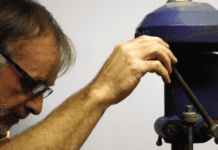It’s possible to forget why you sail -especially, believe it or not, if you deal with sailing for a living. I’ve managed to forget several times over the years. Usually what brings me back is getting offshore with a crew of friends, but I haven’t been able to do that recently. I spend more time banging around in small powerboats these days, because they make for faster gear testing. Deadline’s nigh, gotta fly!
Gear-testing aside, powerboating, I think, is completely goal-oriented. You’re always off to go fishing, or on a “poker run,” or to a beach, or in a convoy with other powerboaters to an island rendezvous somewhere. It’s fast, loud, and efficient, but there’s not much to learn-no wind angles to agonize over, no leads to tweak, no backstay adjustments, no running rigging to untangle, nothing to pull on- just a throttle and steering wheel, and maybe some trim tabs. Whenever I’m on a powerboat now, if we haven’t gotten where we’re going in about five minutes, I begin looking for something to do, and there’s nothing. Even driving gets pretty boring.
My colleague Chris Landry, who edits Powerboat Reports, lives to fish. He and his pal Bill Sisson, editor of Soundings, are always sneaking off in the middle of the night to stand in the cold and catch the flashing creatures of the deep, and of course they get to see the sights while doing so. But fishing gives them an excuse, a raison d’etre on the water. To them, a good boat is one that can get them through the waves to the fish.
Sailors can be goal-oriented, too, especially racing sailors and passagemakers, but in neither of those cases are mere speed and efficiency the motivating factors, the wellspring of contentment, although both are deeply valued. No, there’s something underneath the flailing elbows and tactical thrills of racing, and the careful weather-watching and wonder of landfall in passagemaking. It’s such a simple thing, so obvious, and yet so easily overwhelmed and forgotten.
It’s the mere act of sailing-the ability to travel by means of your own skill, right along the junction of air and water, using a device as simple as a sailboard or complex as a tall ship, to dig down a bit into the liquid for leverage, and up into the air for power, and go where you want.
I rediscovered it after the racing season ended, and I was about to put the Laser away for the winter. It was a warm fall day with a light southwest breeze and a bit of haze. I just went for a sail, with no one to compete against, and nowhere I had to go. I went in a big loop, for miles. There was an occasional puff that let me hike out, but most of the time I could just sit with tiller in one hand and sheet in the other. Somewhere in the middle of this sail I forgot about the job, the bills, the kids in school, the insurance, the news of the day, the rush of demands, and just sailed on. The boat didn’t have to be trimmed perfectly and I didn’t have to think furiously about my next move. What I noticed, but without any particular sense of urgency, was that wonderful dynamic of the wind fluid and the water fluid and the responsive boat moving between them. I was delighted just to be in the middle of it, almost like an observer, although somehow my hand played a part in it.
It lasted an hour or so, and was worth six months of the grind.
That contentment, or “oneness,” I think, underlies everything in this calling. We all must have felt it from time to time, or we wouldn’t be involved. We’d be doing something sensible.
Software, barbeques, diesels, varnishes, and shackles-the things we talk about in these pages-are all parts of what we do, and the way they work can add to or detract significantly from the fun-but it’s also easy to let them slip into the center ring and take over the show.
What draws us back doesn’t really involve gear at all. It’s a state, not a thing. I just don’t know why it’s so difficult to attain.
-Doug Logan



































